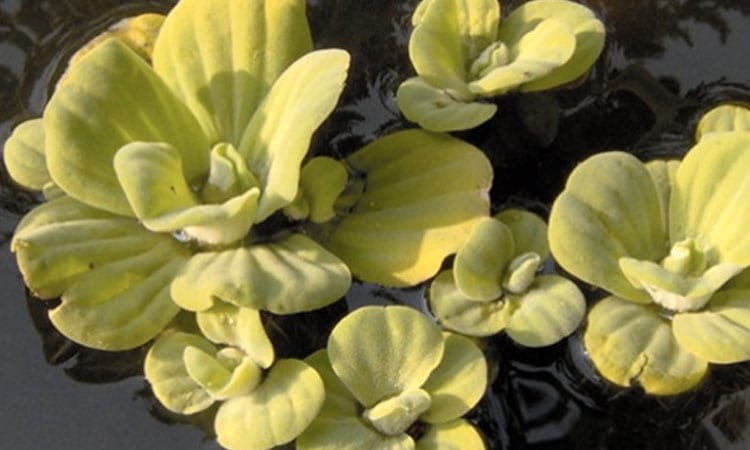A field of free-floating weeds resembling the open heads of lettuce or immature cabbage plants on still or slow moving water.
- English Name: Water Lettuce
- Latin Name: Pistia stratiotes L.
- Life Cycle: Perennial
- Habitat: Aquatic weed worldwide in rivers, lakes, and ponds of temperate climates
- Location: Water lettuce is present in the southeast U.S. and north to New Jersey and New York, and westward to Texas, Arizona, and California. Also presenting Hawaii, Puerto Rico, and the Virgin Islands.
- Original Location: Some believe it is a native plant others believe it was spread here from explorers ships
ONE OF A KIND LAKE WEED
It is usually difficult to identify a particular weed from other related weeds. But not with the Water Lettuce weed. This is one is pretty much one of a kind. It looks like a floating open head of the lettuce you know, much like an immature cabbage before it closes into a ball. It has large leaves typically about 6 inches long that are covered with fine hairs that give them a feathery look. The leaves are light green, soft, thick and arranged like the petals of a rose flower around a central point. Just like the leaves of a real lettuce or cabbage. In fact, the water lettuce weed is also sometimes called the water cabbage, shell flower or the Nile cabbage. Opinion is divided over where the Water Lettuce originated. The most interesting account is that they were first discovered in the Nile, near Africa’s largest fresh water body, Lake Victoria – hence the name the Nile Cabbage. What is certain is that they are not native to the US although they are now quite common across the country, particularly in the southern parts. The weed prefers fresh, open and still or very slow moving water, but has been known to thrive in mud.
THE COMPLEX DESIGN OF THE SIMPLE LOOKING WATER LETTUCE
The Water Lettuce – scientific name, Pistia Stratiotes – is a complex weed despite its simple cabbage look. In the right season, the nicely arranged leaves hide a flower that is hard to spot at first glance. The flower matures into a seed that forms one reproductive system for the plant. At the same time, the each plant forms offshoots of new plants from the side, which quickly grow into new plants while remaining connected to the mother plant until their weight, wind or water currents eventually break them apart. The effect is that while each plant appears to grow singly, many of the plants are linked together by a network of shoots to form a tight mass of weeds. They are, in other words, communal weeds. That linkage is important because the Water Lettuce is a free floater with no anchorage to the water bed. Holding together allows the whole body of weeds to resists wind and water currents that would otherwise restrict their spread. The roots hang in the water and are as feathery as the leaves. Each plant has lots of roots, in keeping with the communal spirit.
WATER LETTUCE WEED CONTROL
Water Lettuce weeds are surprisingly aggressive colonizers of their environment. Using the vegetative offshoots, they grow rapidly, taking over just about every available space in the water. In high nutrient water such as water contaminated sewage or fertilizers the weed has been known to have up to 1,000 of those offshoots in a meter square of water. The Water Lettuce weed is a popular aquarium plant and looks good in ornamental ponds. But in the wild, it is a problem. It does clean water of waste such as sewage, and prevents algae blooms but water birds or animals rarely eat it. The result is that wherever it gets a footing, it grows into a hindrance to fishing, transportation and recreational use of the water. In places where it becomes necessary to control Water Lettuce, two methods are normally used. In very large water bodies, two insects a weevil from South America and a moth from Thailand have shown great promise in eating their way through the weed. In smaller water bodies, such as ponds, dams and small lakes, the typical control method is physical removal. The Deskuzzer, one of our weed control products, is a particularly effective tool for the job because it has a long reach that allows one person to cover a wide area of the water from one position. The Deskuzzer is a 5 foot wide floating seine with sturdy abrasion, ultra tough screen, and a 24 foot pull line.
WATER LETTUCE QUICK FACTS
How does Water Lettuce propagate?
Mostly offshoots of new plants, also by seeds
What are the symptoms of Water Lettuce?
A field of free-floating weeds resembling the open heads of lettuce on still or slow moving water
What are the dangers of Water Lettuce?
Blocks sunlight from reaching submerged plants, affects boating and recreation
Which states and or countries are affected by Water Lettuce?
Believed to be native to Africa, found across the world including the US, particularly southern parts
How can Water Lettuce lake weeds be eradicated?
Nets, Rakes, Removal tools, Deskuzzer, Lake Water Blanket

